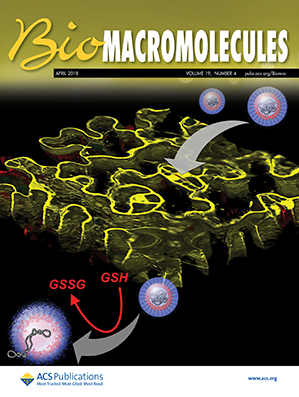Understanding the Role of Surface Chemistry in Nanocellulose Kink Formation: A Case Study of TEMPO-Mediated Oxidation
IF 5.4
2区 化学
Q1 BIOCHEMISTRY & MOLECULAR BIOLOGY
引用次数: 0
Abstract
This study found that the sources of cellulose have a significant effect on the parameters related to the kinks present in nanocellulose. During nanocellulose preparation, 2,2,6,6-tetramethylpiperidinyl-1-oxyl (TEMPO)-mediated oxidation induced partial depolymerization on whole cellulose and made the amorphous regions more susceptible to consequent mechanical treatment irrespective of cellulose sources. However, plant cellulose microfibrils were prone to break into shorter nanocellulose with fewer kinks, while bacterial and tunicate cellulose were more likely to bend rather than break, thus leading to the generation of more kinks. The kinks did not show significant effects on the size, crystallinity index, and thermal properties of nanocellulose for each cellulose source, though the kink numbers were positively related to the mechanical performance of nanocellulose. Collectively, this study elucidated the kink formation mechanisms and clarified the effects of kinks on nanocellulose performance, thus providing new insights into understanding the source and behaviors of microdefects present in nanocellulose.
- Download: Download high-res image (106KB)
- Download: Download full-size image
了解表面化学在纳米纤维素扭结形成中的作用:TEMPO 介导的氧化案例研究。
这项研究发现,纤维素的来源对纳米纤维素中存在的扭结相关参数有显著影响。在制备纳米纤维素的过程中,无论纤维素来源如何,2,2,6,6-四甲基哌啶-1-氧(TEMPO)介导的氧化作用都会引起整个纤维素的部分解聚,并使无定形区域更容易受到后续机械处理的影响。不过,植物纤维素微纤维容易断裂成较短的纳米纤维素,扭结较少,而细菌和鳞毛纤维素则更容易弯曲而不是断裂,从而导致产生更多扭结。对于每种纤维素来源,扭结对纳米纤维素的尺寸、结晶度指数和热性能都没有显著影响,但扭结数与纳米纤维素的机械性能呈正相关。总之,本研究阐明了扭结的形成机制,阐明了扭结对纳米纤维素性能的影响,从而为理解纳米纤维素中存在的微缺陷的来源和行为提供了新的见解。
本文章由计算机程序翻译,如有差异,请以英文原文为准。
求助全文
约1分钟内获得全文
求助全文
来源期刊

Biomacromolecules
化学-高分子科学
CiteScore
10.60
自引率
4.80%
发文量
417
审稿时长
1.6 months
期刊介绍:
Biomacromolecules is a leading forum for the dissemination of cutting-edge research at the interface of polymer science and biology. Submissions to Biomacromolecules should contain strong elements of innovation in terms of macromolecular design, synthesis and characterization, or in the application of polymer materials to biology and medicine.
Topics covered by Biomacromolecules include, but are not exclusively limited to: sustainable polymers, polymers based on natural and renewable resources, degradable polymers, polymer conjugates, polymeric drugs, polymers in biocatalysis, biomacromolecular assembly, biomimetic polymers, polymer-biomineral hybrids, biomimetic-polymer processing, polymer recycling, bioactive polymer surfaces, original polymer design for biomedical applications such as immunotherapy, drug delivery, gene delivery, antimicrobial applications, diagnostic imaging and biosensing, polymers in tissue engineering and regenerative medicine, polymeric scaffolds and hydrogels for cell culture and delivery.
 求助内容:
求助内容: 应助结果提醒方式:
应助结果提醒方式:


